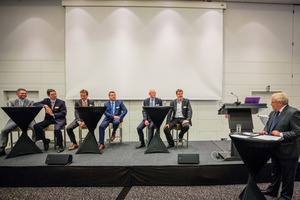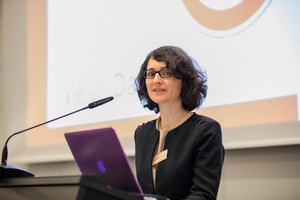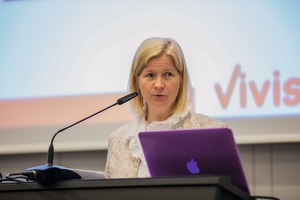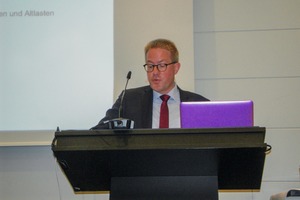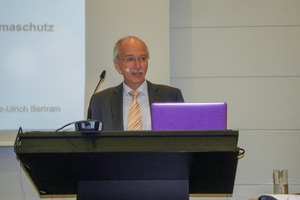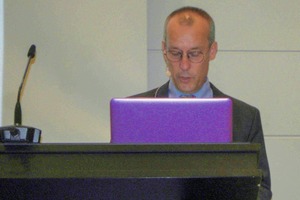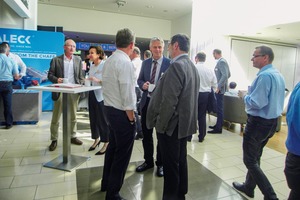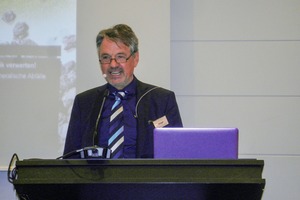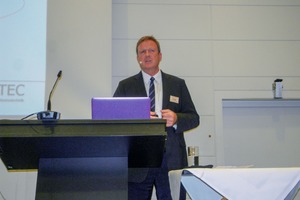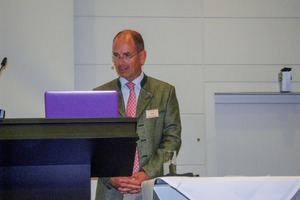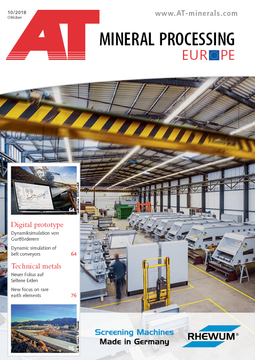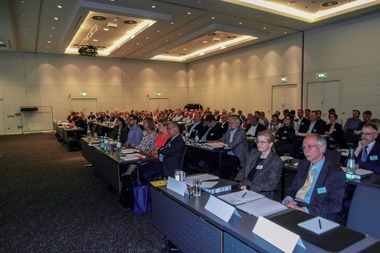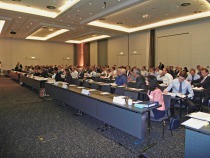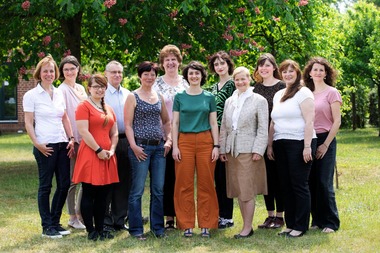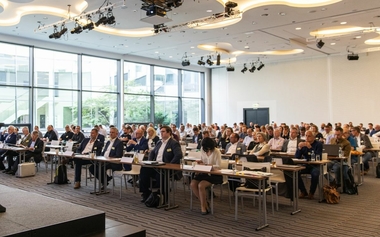Umbrella Ordinance finally in the homestretch - really?
The conference was inaugurated by M. Sc. Elisabeth Thomé-Kozmiensky, managing director of the now called Thomé-Kozmiensky Verlag GmbH Neuruppin, who explained the change of name of the TK Verlags Nietwerder-Neuruppin to become the company mentioned before. With this new constellation, the organization of the Conference remains in experienced hands – already taking place for the sixth time in a row. Thomé-Kozmiensky announced some news to that effect, as inter alia, the initiation of new projects, such as the Berlin Sewage Sludge Conference (Berliner Klärschlammkonferenz) from this year onwards and the enrichment of the conference proceedings in book form by abstracts in English. Due to the new data protection regulations (GDPR), the index of authors has changed as well.
In her introduction to the conference‘s topic, Dr.-Ing. Stephanie Thiel, Thomé-Kozmiensky Verlag GmbH Neuruppin and scientific coordinator of the conference, again explained the long way to the adoption of the national Umbrella Regulation (MantelV), which should already have occurred last year. In the Federal Council, however, it failed, because the State of Hesse excerted its veto right, so the draft regulation had to be revised once again. Meanwhile, the parliamentary elections took place, the formation of the government took a long time and, finally, the ad-hoc working group met for the first time on 08.05.2018 to – once again – discuss the 3rd working draft of the MantelV. The statements of the individual federal states varied considerably and included even rejections. The associations of the construction industry still reject the regulation due to excessive limit values and drastic shifts in volume to landfills, which are to be expected. “So, what to do? See the regulation through or relaunch it? The Federal Council is faced with difficult questions and decisions,”concluded Dr. Thiel and referred to the respective plenary speeches which would probably shed light on the whole issue. Dr. Thiel closed her interesting explanations with a word of thanks to the advisory board and the scientific program committee which, with Prof. Dr.-Ing. Dr. h. c. Bernd Friedrich, Prof. Dr.-Ing. Thomas Pretz, Prof. Dr.-Ing. Peter Quicker and Prof. Dr.-Ing. Hermann Wotruba, all RWTH Aachen, is again composed of renowned scientists.
Relaunching the Umbrella Ordinance
The morning session of the plenary‘s first conference day was exclusively dedicated to the Umbrella Ordinance and ended with a dedicated panel discussion.
The audience expected statements on the status of the regulation packet by the Federal Ministry for the Environment, Nature Conservation, Building and Nuclear Safety ‘straight from the horse‘s mouth‘ and on the further proceeding by Michael Heugel, Deputy Head of Section. Based on the starting situation - inconsistent and partly obsolete framework conditions for the recycling of mineral wastes (BBodSchV - 1999, LAGA M 20 - 1997/2003, Technical Instructions on Soil - 2004, as well as decrees, administrative provisions and regulations), to a large extent lacking legal validity, the further development of the scientific basis and the professional standards, furthermore uncertainties regarding in the implementation as well as the lacking acceptance of secondary raw materials – the speaker presented the history of the MantelV up to the formation of the aforementioned ad-hoc working group (WG). The latter is open to all federal states and staffed with representatives of LABO and LAGA (federal government/states working groups soil and waste) to prepare the Federal Council‘s procedure. While the WG aims at introducing the current revised draft to the Federal Council to enable the procedure‘s start after the summer break, “it must nevertheless be feared that there will be no unanimous opinion. However, the procedure in the Federal Council is necessary to, at least, win over majorities,” says the speaker. In the subsequent lively discussion, inter alia, the procedure‘s delay was debated, which is due to the states‘ introduction of amendments that will then have to be adopted again by the federal cabinet and the Bundestag. New time delays are considered very realistic. However, the flexibility clause provided in the coalition contract (legally protected maintenance of state-specific regulations for the backfill of mines, opencast pits etc.) could really have a positive impact.
With a wealth of experience made in Lower Saxony, Undersecretary Dr.-Ing. Heinz-Ulrich Bertram, Lower Saxony Ministry for the Environment, Energy, Construction and Climate Protection, Hanover, critically examined the recycling of mineral waste under the meaningful slogan: “Looking back into the future” (LAGA M 20 - EBV). Despite all the advantages the recycling of mineral waste offers, the speaker pointed to the considerable impact on the environment and the economy it may entail and reminded of the scandal caused by the recycling of PAK-contaminated building rubble in one section of the German motorway A7. In the Closed Substance Cycle Waste Management Act (lKrWG) it is already explicitly specified that recycling may only be allowed if its harmlessness is guaranteed. Dr. Bertram went into the details of the current valuation bases – LAGA M 20, technical regulations of the Federal States Committee on Mining, DepV – and reported about the positive implementation experiences: implementation occurs almost “automatically” without the use of General Comments, while recycling rates of about 90 % have been reached for years. According to Dr. Bertram, the EBV does not have a consistent and coherent valuation concept, the regulatory objectives are clearly missed, there is no simplified implementation of regulations and no sufficient groundwater protection. Thus, the EBV means renouncing the professional concept of holistic preventive waste management in favor of the political objective of high recycling rates, renouncing the harmless utilization and the preventive protection of soil and water, renouncing the waste management‘s renal function and the surrender to the demand for landfill capacity. Taking a look back into the future shows that pollution is no solution for the environment; in the long run, pollutants in wastes as well as breaches of law cannot be kept secret. If discovered, they result in considerable losses of acceptance while the subsequent costs have to be born by the purchaser (in case of public building projects, the taxpayer). With regard to landfill demand, the MantelV will increase the problem, because the EBV will considerably decrease the acceptance of substitute building materials, and a mass return to landfill sites will take place, which however are not sufficiently available in most states.
The “Development status of the MantelV with the focus on the Federal Soil Protection and Contaminated Sites Ordinance” was discussed by Undersecretary Prof. Dr. Jens Utermann, Ministry for Environment, Agriculture, Nature and Environmental Protection of the state of North Rhine-Westphalia, Düsseldorf. In this context, he went into the structural and content-related changes of the applicable BBodSchV (German Federal Soil Protection Act and Ordinance) from 1999. While this has proven its worth, there are still reasons in favor of a new version:
(Further) development of suitable procedures for the seepage prognosis
Extension of the list of examination and action values for the exposure pathway ‘man - soil‘
Control of precautionary levels
Derivation of examination values for the exposure pathway ‘soil - soil organisms‘
The structural changes aim to achieve a simplification of the previous appendices; the content-related changes refer to the regulations on the preventive soil protection. The speaker explained details and closed his speech with statements on the update of examination and action values.
Panel discussion “Umbrella Ordinance and no end – staying the course or relaunching?”
An entirely justified question, in view of the many uncertainties, disagreements, long negotiations on political and trade association level, the following experts from politics, economy and science, had to deal with:
Undersecretary (MR) Heinrich Becker, Saarland Ministry for Environment and Consumer Protection, Saarbrücken
Dr.-Ing. Alexander Gosten, board member of the Deutschen Gesellschaft für Abfallwirtschaft e. V., Berlin; authorized signatory of the BSR Berliner Stadtreinigungsbetriebe
Thomas Reiche, Managing Director (GF) of the FEhS – Institut für Baustoff-Forschung e. V., Duisburg
Stefan Schmidmeyer, Managing Director (GF) of the Bau-stoff Recycling Bayern e. V., Munich
Dipl.-Ing. Wolfgang Schubert-Raab, co-opted board member of the Zentralverband des Deutschen Baugewerbes e. V., Berlin.
Michael Thews, reporter for recycling economy and resource protection of the SPD parliamentary group, Vice Chairmen of the Environmental Committee of the Bundestag (MDB)
The independent journalist, Joachim Mahrholdt, presented the discussion inviting the participants to give a short statement. First, he asked MDB Thews, why the adoption of the MantelV took such a long time. And now a typically political answer: “Such projects, just like the AbfKläV (Sewage Sludge Ordinance) or the VerpackV (Packaging Ordinance) are so lengthy, because the individual states and their previous approaches need to be taken into consideration. Of course, we want more waste recycling, thus more substitute construction materials, and therefore the latter must be clearly defined. With the draft of the MangelV we are on the right track – and we do not start from the scratch.” The presenter immediately objected: “However,
at some point the debate must come to an end. Finally, one has to purse one‘s lips and whistle!”
MR Becker clearly confirmed his commitment to national regulations, which were necessary, but considered federalism just as advisable. It is important to support recycling, but also to protect the environment, for which local interest would have to be taken into consideration. As the representative of the building industry, Dipl.-Ing. Schubert-Raab argued for more recycling and less landfilling. The building industry likewise commits to consistent regulations, also to the MantelV, however not in the form currently intended. Considerations must also include costs and impact. “Our company develops 50 000 tons of soil each year. Twenty years ago, 20 % of it were dumped. Today, we deliver 40 % to the landfill, which is inconsistent with the idea of increased recycling. Landfills that are only allowed to accept soil class Z.0 are desperately looking for material. The “soil tourism” is flourishing and the transport of bulk solids containing soils has drastically increased, as regional recycling is not possible or only to a limited extent.”
GF Reiche, speaking from the point of view of the sector dealing with recycling of about 13 million tons of slags per year (granulated slags, traffic building material, fertilizers), called for terminating the never-ending story of the MantelV - either way, with or without state regulations, which however would not be a good solution. Another question was: what would happen to the material in the second and third life cycle? Would it be waste or byproduct? GF Reiche fears state-specific regulations would remain in force if the EBV is not integrated in the MantelV.
GF Schmidmeyer could fall back on a wealth of experience in Bavaria, as there, regulations similar to those considered in the MantelV and serving quality assurance have been in place for 13 years. However, environmental compatibility is not everything. Customers also require legally binding and nationally consistent regulations! Above all, installation after the removal should be ensured. Natural resources are getting less and less, therefore we need recycled construction material, however only soil class Z 0 is in demand. The LAGA M 20 causes a lot of trouble throughout Germany. If the procurement law shall make sense, nationwide compromises will be required, as building contractors deal with customers based in most different states. Thus, if RC building materials shall be supported, consistent regulations will be indispensable. “With the draft of the MantelV, the biggest step was made. I therefore ask the states to come to an agreement in the Federal Council”, GF Schmidmeyer closed his speech. Dr. Gosten, who criticized that the interests of the DGAW and the BRS were not taken into consideration, went into the high priority of the concerns contained in the MantelV and the numerous necessary risk assessments associated with them. He mentioned the geogenic pollution in some regions just like the existence of heavy metals and trace elements in food supplements and considered the non-harmonization of limit values a big problem. “Concern or danger? – This question needs to be answered,” says Dr. Gosten and the presenter came to the conclusion: “We shouldn‘t get carried away,” which was broadly accepted.
A discussion followed involving the audience. MR Dr. Bertram got to the heart of it: “Sustainability is the keyword that unites us all.” Since soils are already geogenically polluted, we mustn‘t add further pollution. The management needs clear action rules, and an adequate system needs to be maintained. Moreover, the communication of facts and issues is of utmost importance.
RD Heugel was of the opinion that the LAGA M 20 (status quo) is already good, but not sufficient. Example: solids values. Furthermore, the implementation, which would be regulated by the MantelV, is very varied.
Further discussion points included:
The frequently lacking sustainability (transport to remote landfills, acceptance of soils but no treatment in disposal facilities, as there is no significant demand for RC materials, thus they eventually end up in landfills)
Recycling rates – recycling quota
Removal and installation of geogenic soils – enrichment yes or no
Flexibility clause in Para. 2 EVB – state-specific regulations regarding backfilling, which have proven their worth, can be maintained in legislation
In summary, the discussion showed that all panelists wanted to adopt the MantelV, but showed resentments regarding material data and installation methods. There was nothing new announced, which means, a readjustment should finally take place and the small time slot should be used to bring the state-level discussion to an end.
Finally, the presenter asked the conversation partners in the panel: “In one year from now, where will the MantelV be?” Hope prevailed that the Ordinance will come into force, although only cautious optimism could be felt. But MDB Thews was convinced: “After this discussion I am confident, because the coalition wants the Ordinance; the Ministry takes this topic very seriously and therefore I think the MantelV will come into force, the German federation will not block it.” Desire or reality? This remains to be seen at the next event.
Ashes from waste incineration plants – important raw materials
The first part of the lectures held in the afternoon meeting dealt with the recycling of ashes from waste incineration plants (MVA). Dr. Rudolf Diegel, REMEX Mineralstoff GmbH Düsseldorf, presented the company‘s concept regarding the processing of ashes from MVAs. The semi-dry mechanical processing with pneumatic-ballistic fine-grain separation is in operation at three locations, e.g. in the Netherlands for the production of concrete granulates. In connection with the topic of the Berlin conference, the speaker criticized the significant decline in recycling of MVA minerals in road construction which is to be recorded almost everywhere in Germany, except for Hamburg (75 % in road construction, 25 % other kinds of recycling). He revealed the extreme regional differences including a north-south divide and complained about the lacking support of public clients with regard to bidding processes. From an economic point of view, the aim of MVA ash recycling is the optimum metal recovery with the simultaneous use of minerals (price comparison metal/minerals = 1000/1). Fields of applications are cement and concrete plants. Thus, what needs to be done to return to a higher recovery rate? Eventually, the adoption of a national set of rules, more research for the use of minerals, the improvement of the bidding practice and comprehensive public relations work.
In Switzerland, which has sufficient primary building materials, the main focus when recycling MVA ashes is set on the recovery of metals, as demonstrated by Prof. Dr. Rainer Bunge, Hochschule für Technik, Rapperswil/Switzerland. By means of so-called maximized (in contrast to maximum) metal recovery, minerals are crushed to such an extent that they are no longer usable as building materials and must be landfilled. However, about two thirds of the NE-metals > 2 mm contained in the MVA ash, corresponding to about 20 kg/t of raw ash, are recovered. The speaker considered ecological aspects regarding both the recycling of minerals and the maximized metal recovery in the form of positive and negative environmental performances. The result is unambiguous: maximized metal recovery outmatches the recycling of minerals both with regard to eco-efficiency and eco-effectiveness. However, maximized metal recovery is also more expensive. Prof. Bunge suggests to reconsider the recycling of MVA ashes in Germany (about 7 m t/a), and perhaps to follow the Swiss model, since the ecological benefit, for example, of plastics recycling (yellow bag) is 23 times higher.
In his speech entitled “The mineral fraction of bottom ash – the 85 %-problem”, Dr.-Ing. Thomas König, GfA Gemeinsames Kommunalunternehmen für Abfallwirtschaft A.ö.R., Olching, initially raised the question whether rust shedding from waste cogeneration plants was a valuable raw material or a disposal problem. In this case, the internal and external perception are totally different: producers realize the excellent properties of the ash and their contribution to the conservation of resources. According to the external perception however, it is hazardous waste and thus a potential legacy. A market is required, not based on regulation, but on competitive products. Landfilling is no solution, neither for producers (in the long run, landfill space gets scarce), nor for recyclers (landfilling does not require recycling). Thus, solutions are urgently needed to achieve a recovery rate of 85 %.
Legal aspects
The complexity of liability issues in the field of recycling of construction wastes was highlighted in the speech given by Prof. Dr. Andrea Versteyl, Andrea Versteyl Rechtsanwälte Partnergesellschaft mbH, Berlin (Liability under public and private law regarding the disposal of construction wastes in the relationship between authorities – waste producers – disposal companies), who succeeded in presenting this complex topic comprehensibly and in the short time available. Against the background of the recycling goals set out in the raw material efficiency program (from 2020, 65 % for municipal waste, 70 % for construction and demolition wastes), lawyer Gregor Franßen, Henemann & Partner Rechtsanwälte Partnerschaftsgesellschaft mbH, Essen, sees a contradiction between ambition and reality. In his lecture, he described the need to improve the legal framework on waste and procurement for the use of mineral substitute building materials and went into country-specific situations. Improvements include:
Implementation of the requirement to use mineral substitute building materials (MEB)
Establishment of bidders‘ rights with regard to utilization
Admission of MEB in (ancillary) offers
Landfills in the focus
In particular in connection with the MantelV, discussions about landfills play an important role. Thus, even the last speech of the first conference day was followed with great interest: Dipl.-Verww. Hartmut Haeming, chairman of the management board of the Interessengemeinschaft Deutsche Deponiebetreiber e. V., Cologne, described the situation of landfills in Germany and went into issues like bottlenecks, remaining life and plans for new constructions. The audience gained a detailed overview of the situation in the individual federal states. Despite recycling as a requirement, “landfills will be necessary as ‘ultimo ratio‘ even in future: but who shall be responsible for them? Public bodies or the private sector? This is a political decision!”, the speaker introduced his explanations. The analysis of the situation in the federal states showed that disposal safety only exists in Mecklenburg-Vorpommern. While the values for mass return to landfill dumping expected from the MantelV vary considerably (BMU ~ 13 m t/y, BDE ~ 50 m t/a, ZDB ~ 50 m t/a), they show the seriousness of the situation and the need to quickly develop new land for landfills. This concerns both the complete technical exploitation and the expansion of existing landfills as well as new constructions.
Specialist sections
The lectures of the second conference day were held, in a proven way, in four parallel events covering scientific-technical topics. Procedures, scientific examinations and projects were presented as well as operational experiences and plants. From the abundance of lectures, only a few can be mentioned and briefly outlined within the context of this report.
1 Residues from waste incineration
This section covered a broad range of topics, from bottom ashes and fly ashes up to carbon-fiber containing (CFK) wastes from domestic waste incineration plants. Regarding the treatment of domestic waste, M. Sc. Jan Stockschläder, RWTH Aachen, presented intermediate results from practical examinations on an industrial scale. He explained the problem those fibers may cause in electric separators as well as their probable categorization as carcinogenic fibers according to the WHO after their thermal treatment (not yet verified, project submitted for toxicological examination). The speaker reported on large-scale tests in the municipal waste incineration plant of Coburg under the addition of dry wastes with CFK. The additions did not interrupt the operational procedures, but in the bottom ash, a significant proportion of CFK arises which is particularly high in the fraction of 10 – 30 mm and which decreases with decreasing grain size. The same applies to residues from exhaust gas purification. Following the successful large-scale tests, the quantitative analysis of the fraction < 1 mm is planned, with the focus set on the critical fibers.
Dipl.-Ing. Böni, ZAR Center for sustainable management of recyclable waste and resources, Hinwil/Switzerland shared his operational experience gained with the world‘s first processing plant for MVA slags discharged in the dry stage. He described the multitude of advantages compared to wet slags and showed the added value enabled by slags processed in this way: more than 15 % of metals can be recovered, with over one third being environmentally relevant NE-metals. Furthermore, 60 000 t/a of CO2 are saved. In future, the recycling rate of the arising mineral fraction (the remaining 85 %) shall be improved, since further contaminants still have to be removed to guarantee long-term maintenance-free dumping.
Further lectures dealt with the use of bottom ashes in the building material industry, covering technical aspects and legal framework conditions alike. However, fly ashes were also under consideration, for example in the speech held by Dipl.-Ing. Jörg Eckardt, JE-C GmbH, Luedge, who presented a new method for the treatment of ashes – conversion – or by B.Sc. Dominik Blasenbauer, Institute for Water Quality and Resource Management, TU Wien/Austria, who proposed pelletizing in combination with thermal treatment as an alternative.
2 Byproducts from metallurgy
In this section, both legal and technical matters were discussed. Dipl.-Ing. Thorsten Thörner, Wirtschaftsvereinigung Stahl, Düsseldorf dealt with the recycling of by-products resulting from steel production against the background of national and European developments in politics and legislation. The versatility of practice-relevant examinations and results was reflected, inter alia, in speeches by M.Sc. David Algermissen (practice-oriented development of new products from LD slag) and Dr.-Ing. Peter Drissen (second generation Thomas slag – a new development full of potential), both FEhS Institut für Baustoffforschung e. V., Düsseldorf, or Dr. rer. nat. Michael Dohlen, Thyssenkrupp MillServices & Systems GmbH, Oberhausen (use of steelmaking slags in unbound construction). A nice overview on gas purification in metallurgic processes was provided by Dr.-Ing. Johan Heiszwolf, Lhoist Recherche et Développement SA, Nivelles/Belgium. Another interesting speech was held by Dipl.-Ing Klaus Kiwitt, Befesa Salzschlacke GmbH, Hanover, who presented a method for the treatment of salt slags arising from the recovery of secondary aluminum from AI scrap. “The method is characterized by a residue-free procedure, which results in a sustainable and environmental-friendly raw material,” said the speaker. Apart from AI granulate, ammonium sulphate and recycling salt (Resal), an aluminum oxide product is produced (67 – 69 % Al2O3), which substitutes primary raw materials, inter alia, in the cement and the refractory industry. The company runs four treatment plants (Lünen, Hanover, Valladolid/Spain and Whitchurch/Great Britain. The lecture series ended with a no less interesting speech by M. Sc. Lilian Peters et. Al., RWTH Aachen, on the recovery of Li and Co from slags of battery recycling. In this context, a flexible method using an electric arc furnace as central aggregate was presented, which showed the potential for the recycling of both metals mentioned before, but did not conceal the difficulties of the technical implementation.
3 Construction waste
The lectures on “The consequences of the HP 14 regulation on the demolition and recycling industry from the Austrian point of view” by Dipl.-Ing. Thomas Kasper, Porr Umwelttechnik GmbH, Vienna and “Recycling-oriented renaturation according to the new ÖNORM B 3151” by Dipl.-Ing. Martin Car, BRV Österreichischer Baustoff-Recycling-Verband, Vienna, and “Recycling and reuse in the remediation of infrastructure facilities using the Vienna underground line U4 as an example” by Dipl.-Ing. Andreas Gassner, TU Vienna, provided an insight into the Austrian construction material recycling industry. These speeches showed how the objective of the Austrian Recycling Building Material Ordinance, in particular the safeguarding of high qualities of secondary building material, can be reached. However, there is no lack of new research results and applicational experiences in Germany, as the lectures held by M. Sc. Stefan Huber, TU Munich (“Utilization of recycling building materials from processed mineral construction waste in earthwork”), by Dr. rer. Nat. Sebastian Dittrich, Fraunhofer Institut für Bauphysik IBP, Holzkirchen (“Processing and recycling possibilities for fine-grained building rubble < 2 mm”) or by Christian Salzmann, Remondis GmbH & Co. KG, Mannheim (“Construction and first operational experiences with the recycling plant for plasterboards and other gypsum-based waste in Zweibrücken”) demonstrated.
4 Landfills
As already sufficiently explained, with regard to the Umbrella Ordinance the dumping of wastes gained new significance. Therefore, it is not surprising that the increase in landfill capacities was in the focus of this section, for example the expansion of the landfill Wiesloch (Dipl.-Ing. Wolfgng Wesch, AVR Kommunal GmbH, Dossenheim) and the Southern enlargement of the central landfill Hubbelrath (Dipl.-Ing. Jörg Piepers, Zentraldeponie Hubbelrath GmbH, Düsseldorf). However, the topics of Landfill Mining such as “Enhances Landfill Mining – The EU project New Mine” by Prof. Dr.-Ing. Thomas Pretz, RWTH Aachen, or “Mineral wastes from the renaturation of nuclear installations – approval for landfill and other disposal methods” by Dipl.-Ing. Franz Borrmann, iUS Institut für Umwelttechnologie und Strahlenschutz GmbH, Aschaffenburg, were discussed. Two lectures on emissions rounded the landfill subject off: Prof. Dr.-Ing. Gerhard Rettenberger, Ingenieurgruppe RUK GmbH, Stuttgart, spoke about emissions from DK I landfills, while Dr. rer. nat. Jan Küver, Official Material Testing Facility of the Free Hansa Town of Bremen, addressed the utilization of cellular concrete and lime-sand brick quarries as bioactive functional layer for the oxidation of methane outgassing from landfills.
Closing remarks
Even the 6th edition of the Berlin conference “Mineral Byproducts and Wastes” has lost nothing of its topicality, its versatility and its wide range of topics. Competent speakers provided a wealth of both legal, political and expert knowledge and experiences. Again, the excellent organization of the event must be highlighted. The execution of the panel discussion before the lunch break of the first conference day turned out to be a good solution, as the eagerness of panelists and audience to enter into discussion demonstrated. The conference breaks and an evening event in pleasant atmosphere provided sufficient time for further discussions and personal conversations. While lecturers from Austria and Switzerland have been forming part of the event‘s image for a long time, the contributions from Belgium and the Netherlands have also been rewarding. Altogether, the conference showed that recycling of mineral byproducts and wastes will be further developed in terms of both research and applications, but that politics and legislation – above all due to the lacking adoption of the Umbrella Ordinance – cause uncertainties that should eventually be eliminated. To sum up, the Berlin conference “Mineral Byproducts and Wastes” can be regarded a very successful event.
Most of the lectures contained in the conference program are included in “Mineral Byproducts and Wastes 5 - Ashes, Slags, Dusts and Building Rubble” – Thomé-Kozmiensky Verlag GmbH, Neuruppin 2018, ISBN 978-3-944 310-41-1. The next issue of the Berlin Conference “Mineral Byproducts and Wastes” is scheduled to take place in Berlin on May 13 and 14, 2019.
Autor/Author:
Umweltschutz, Oberschöna

